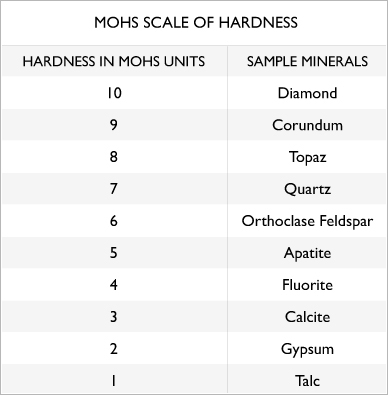What is the luster of this mineral?
Metallic
True or false: color of a mineral is the same as its streak.
False
What is the softest & hardest mineral on the Moh's hardness scale?
Softest: Talc
Hardest: Diamond
A mineral has a mass of 34 g, and a volume of 17 mL. What is its density? (don't forget a label!)
2 g/mL
Name a "special property" that only applies to a few minerals that isn't already listed on this game.
Reacts to acid, magnetism, tastes salty, etc.
Why is color NOT the best way to determine a mineral's identity?
Bonus point: Name 2 reasons.
Many minerals come in the same color; some minerals come in many different colors.
How does a streak test help identify different minerals?
Sometimes the streak can be a different color than the mineral's surface color.
What is the name of the scale used to test a mineral's resistance to being scratched?
Moh's Hardness Scale
A mineral has a mass of 280 g and a volume of 80 mL. Using your mineral identification key, name a mineral this could possibly be.
Nerd point: name both possibilities
Topaz or Diamond.
Name 4 out of the 5 qualifications something must meet in order to be a mineral.
Nerd point: Name all 5
Chemical formula
Atomic Structure
Non organic
Naturally occurring
Solid
Name 4 different terms used to describe the luster of a mineral.
Pearly, glassy, waxy, vitreous, silky, dull, metallic, earthy, greasy, resinous, adamantine
Define "streak."
The color of a mineral in powdered form.
A mineral cannot be scratched by your fingernail. What is the next scratching tool you'd use to test?
Whether or not a mineral will float in water is based on its _________.
Nerd point: when will it float for sure?
density
Nerd point: if its density is less than 1 g/mL
The property of a mineral splitting evenly along a flat surface is
Cleavage
Name three common/every day uses of minerals
- Quartz: used in watches, clocks, and electronic devices.
- Feldspar: used in ceramics, glass, and cement.
- Gypsum: used in drywall, plaster, and fertilizers.
- Halite (salt): used for food seasoning and preserving.
- Calcite: used in toothpaste, antacids, and cement.
- Talc: used in cosmetics, baby powder, and soap.
- Sulfur: used in fertilizers, pesticides, and gunpowder.
- Copper: used in electrical wires, pipes, and coins.
- Iron: used in steel production, tools, and machinery.
- Aluminum: used in cans, foil, and aircraft parts.
- Lithium: used in batteries for electronic devices and electric cars.
- Graphite: used in pencils, lubricants, and batteries.
- Cobalt: used in rechargeable batteries and jet engines.
- Mica: used in cosmetics, paint, and electrical insulation.
- Barite: used in drilling muds for oil and gas wells.
What property is being shown here?
Streak

A mineral is harder than calcite, but softer than apatite. What is it?
Fluorite
A mineral has a density of 4.0 g/mL, and scratches a streak plate. What is this mineral?
Malachite
A certain mineral is described as "conchoidal." What property is being described?
Fracture
Name the most common color of minerals.
White (will also accept colorless)
If a mineral does not leave a streak on your streak plate, what does that tell you about the mineral?
It is harder than the streak plate, and has a hardness greater than 6.5
If you tested a mineral on a piece of glass then you are testing...
Nerd point: if it scratches the glass, then what do you know about the mineral?
Hardness
Nerd point: You know it is harder than 5.5
Object B is 100 g, and 20 mL.
Object C is 93 g, and 4.65 mL.
Which one is real gold?
Object A
Name 4 tools that can help you to identify properties of minerals.
Nerd point: Name 7
Fingernail
Copper Sheet
Metal Nail
Glass Plate
Steel Plate
Streak Plate
Eyeballs
Scale
Flashlight
